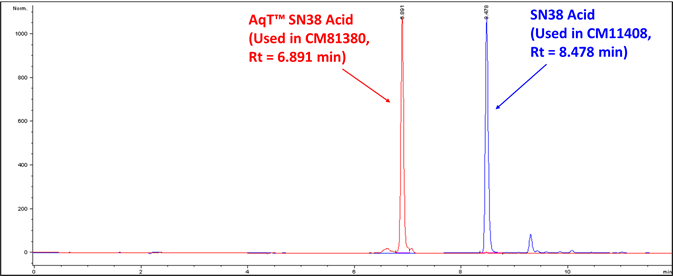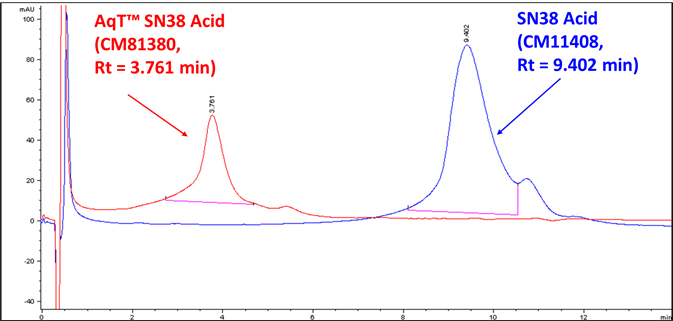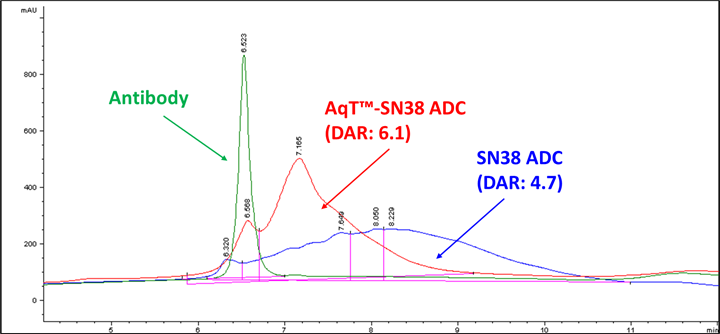Product Overview
SN38 is an inhibitor of topoisomerase I that eventually leads to inhibition of both DNA replication and transcription. On April 7, 2021, the FDA granted regular approval for sacituzumab govitecan (Trodelvy, Immunomedics, Inc.), an ADC that consists of SN-38 linked with a humanized IgG antibody targeted against TROP-2, for the treatment of patients with metastatic triple-negative breast cancer (mTNBC) following at least two prior therapies for metastatic disease. TROP-2 is a cell-surface glycoprotein expressed in more than 90% of TNBCs. Unlike highly toxic chemicals, such as DM1 and MMAE, ADCs with chemotherapeutic drugs may need much higher loading to achieve a therapeutic index. Unfortunately, SN38 is a very hydrophobic molecule. Antibodies labeled with SN38 with classical linkers tend to aggregate and may precipitate out from solution over time.
AqT-SN38 acid (CM81301) is currently available for evaluating the benefit of AqT® linkers for customer's ADC. SN38 modified with super-hydrophilic, water-soluble, and charge neutral AqT® linker greatly increases the hydrophilicity and water solubility of SN38. The hydroxy (-OH) groups of AqT® form a network of hydrogen bonds (H-bond) with neighboring water and create a microenvironment that shields neighboring SN38 from stacking or interacting with one another. This AqT® enhanced H-bond network also protects the antibody from enzymatic degradation and retains its activities. The end result is an ADC with exceptionally high loading with no or minimum aggregation.
This AqT drug can be loaded onto the antibody through an amide bond via the surface amines of the antibody. After AqT® ADC reaches the target, the hydrophilic AqT® linker can be separated from SN38 via its releasable ester bond. This tactic (traceless release) allows: 1) efficient transportation of the ADC in the biological media with minimum aggregation and toxicity, 2) preservation of the bystander killer effect of SN38.
Contact us if you are interested in AqT-SN38 drugs with other release mechanism or labeling chemistry, for example AqT-VC-PAB-SN38.
Key Features of this AqT-SN38 Acid Asset
- Proprietary super-hydrophilic and water-soluble linkage
- High loading with average 5 to 7 SN38 per antibody with minimal added aggregation
- Sugar alcohol-based AqT® linker preserves the properties of the antibody
- Releasable linkage with fully released SN38 (traceless release) to maximize the efficacy
Comparison of ADCs made by CM81301 (AqT-SN38 Acid) and CM11408 (with SN38 Acid)
|
|
ADC by CM81301 (AqT®-SN38 Acid) |
ADC by CM11408 (Ab SN38 Conjugation Kit with Classical Linker) |
|
Proprietary |
Yes (composition of matter protected by AqT® technology) |
No, if your antibody is generic |
|
Linker Properties |
Proprietary super-hydrophilic and water soluble AqT® linker |
Classic hydrophobic ethylene-type linker |
|
Spacer |
Long spacer |
Short spacer (4 atoms) |
|
Releasable Chemistry |
Same (ester bond) |
Same (ester bond) |
|
Loading |
High: 5−7 SN38 per antibody |
Low: 2−4 SN38 per antibody |
|
Hydrophobicity |
Slight changes in hydrophobicity |
Dramatically increases hydrophobicity |
|
Aggregation by SEC |
No or less than 2% added aggregation |
Average 10−50% added aggregation |
|
Heterogenicity by HIC |
Less heterogenicity |
Highly heterogenous product |
|
Stability |
Stable even with high loading: easily stored frozen without any stabilizer |
Unstable even with low loading |
C18 and HIC HPLC Profiles of AqT® SN38 Acid Alone
| Overlay of C18 reversed phase HPLC analysis of SN38 acid and AqT® SN38 acid | |
 |
AqT® SN38 acid has Rt of 1.6 minutes less than SN38 acid with classical linker (11.9% less acetonitrile to elute out) Buffer A: 0.1% TFA in water Buffer B: 0.1% TFA in acetonitrile |
|
|
|
|
Overlay of HIC HPLC analysis of SN38 acid and AqT® SN38 acid |
|
 |
Column-bound SN38 acid needs additional 1M (NH4)2SO4 decrease to elute out compared to AqT® SN38 acid Buffer A: 0.1M Sodium phosphate buffer, 1.8 M (NH4)2SO4, pH 7.0 Buffer B: 0.1M Sodium phosphate buffer, pH 7.0 |
SEC and HIC Profiles of AqT®-SN38 ADC
AqT®-SN38 ADC (SEC HPLC: aggregation profile)

SEC separates the conjugates by apparent MW or size. The larger MW of the conjugate, the earlier it elutes out. Aggregates usually appear to the left side of the product. For SN38 ADC, there is usually 5 to 50% aggregation for a typical ADC with a loading of 2 to 4. For AqT® SN38 ADC with a DAR of 6.1, less than 1.2% aggregation was observed.
AqT® SN38 ADC (HIC HPLC, hydrophilicity and heterogenicity profile)

Due to the highly heterogeneous nature of surface amine labeling, antibody loaded with the same number of drugs (same DAR) may have slightly different hydrophobicity. So, for ADC labeled via surface amine chemistry, a broad peak will be seen in a typical HIC analysis without clear separation of the peaks.
SN38 ADC is highly hydrophobic. After labeling with an average 4.7 SN38 per antibody, the peak retention time of the antibody increases 1.7 minutes (0.36 minutes per SN38). SN38 antibody is also highly heterogeneous with an HIC peak spanning more than 5.2 minutes (1.1 minutes per SN38).
However, for AqT™ SN38 ADC with an average 6.1 AqT™ SN38 per antibody, the increase in hydrophobicity is much smaller (0.1 minutes per AqT™ SN38). AqT™ SN38 labeled antibody is also less heterogeneous with an increase in the peak width of only 0.49 minutes per AqT™ SN38.

